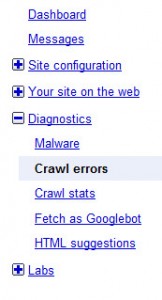Using Google Webmaster Tools for SEO Guidance
Despite the name, “Google Webmaster Tools” is quite useful for search engine companies and business owners because it provides an inside look at how Google views your website. I will review a few of the key “tools” and important information that Google Webmaster Tools provides. Also, how you can use that information to help with your SEO efforts.
Identifying Google Crawl Errors with your Website
While having a website that can be validated by W3C.org is nice with the advancements in browser rendering, it is no longer required. However, some issues still hurt a user’s experience and thus are not liked by Google. As an SEO, I frequently check the crawl errors under the diagnostics left menu item in Google webmaster tools. I am looking to make sure that I do not have any items which Google especially doesn’t like, such as 404’s, which can occur for a number of reasons and hurt the user’s experience.
Sitemap Submission & Identifying Sitemap Issues
If the website you’re managing is using an XML Sitemap, knowing the status, issues, and accepted success percentage of your sitemap is very important. For SEO’s you want to know that each URL that was submitted was accepted. As seen below, three URLs were not accepted and research needs to be done to see why Google did not accept them.
Search Query Relevance
Under the left menu item “Your site on the web” is an area that was expanded greatly by Google. This report now identifies trends in search queries, average position and click through rates for organic traffic. This helps SEO’s by showing a report of which keywords the website you’re managing is generating impressions and clicks for. This type of information is very important, especially If you’re obtaining impressions for irrelevant keywords: for example if you’re a PPC Management Company like EverEffect but you’re being found for “Pied Piper of Hamelin”, that identifies a disconnect with the content and optimization verses your target keywords and services. Thus, you will want to revisit any content that is generating irrelevant search traffic and alter it to make it more fitting for your website and target market, which in turn should decrease your bounce rate and positively impact your SEO.
Site Performance in regards to Speed
As heavily noted, Google has recently been taking site speed into consideration as a ranking factor and while this change only affected a small percentage of websites overall, Google has deemed it important enough to include site speed in Google Webmaster Tools under the left menu item “Labs”. While the overall speed of your website may be fine, this tool shows you trends which can help identify issues with changes made or with hosting. If your average page load time is, for example, 2.3 seconds, but in the report you notice several spikes or an increasing trend of page load time, as an SEO this should be a red flag to start questioning changes made and the quality of hosting services.
While Google has taken lumps recently for search quality, they continue to impress me with the growth of free tools which help both SEO’s and businesses better manage their websites. It is highly recommended that you create a Google Webmaster Tools account for SEO purposes alone, but there are several tools not covered that can help you manage your website more effectively and keep an eye on your host, website manager and SEO.



